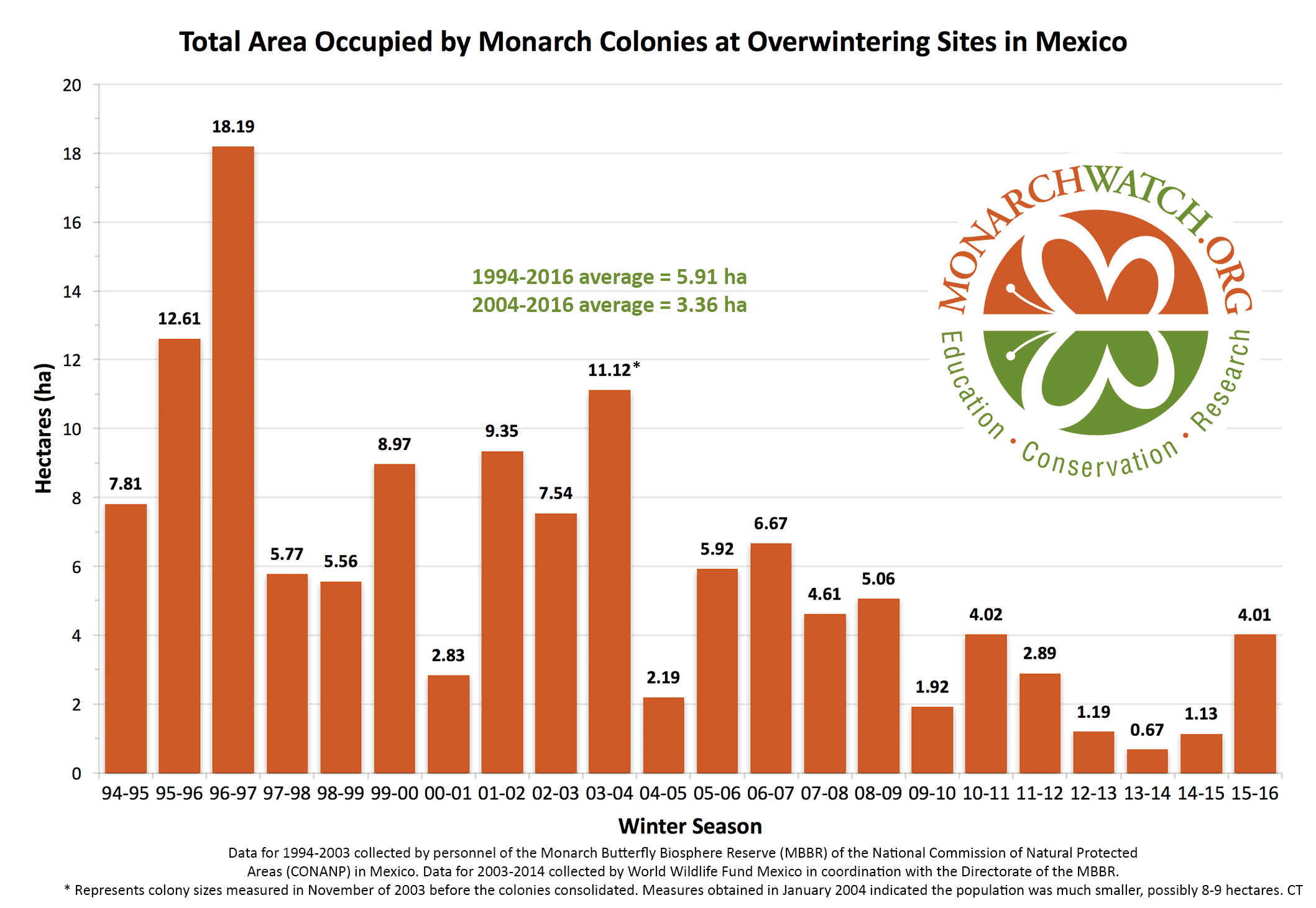Just last week, Monarch Watch, the support organization of the University of Kansas, released their count showing an increased number of monarchs this winter in Mexico. Monarch numbers more than tripled since last winter season.
As you can see from their graph below, in the 2014-2015 winter season, there were 1.13 hectares, or 2.8 acres (2 1/2 acre = 1 hectare) of land covered by monarch butterflies, compared to 4.01 hectares (9.9 acres) this winter season, more than 3 times more butterflies. Looking closely at the graph, you can also see the high year is in 1996-97, where there were 18.19 hectares (45 acres) of land covered with wintering monarchs. The low year was 2013-14, when monarchs only covered .67 hectares (1.7 acres) of land.

There are a number of factors that contribute to a decreased amount of monarchs, many of which relate to loss of habitat in both the summer (Midwest cornbelt) and winter (Mexico) habitats. Of course, deforestation of oyamel forests contribute to monarch's lack of protection during their November - March hibernation. Late winter storms can also have a detrimental effect on monarch numbers.
However, one of the biggest reasons for loss of habitat is that since the late 1990's, farmers have been planting glyphosate tolerant corn and beans. Therefore, when chemicals are sprayed to control weeds in fields, milkweed, the only plant that monarch larva can eat, are also killed, thereby reducing the number of monarch butterflies. Recent efforts to increase milkweed numbers in gardens and non-crop areas, have no doubt helped adult monarchs find places to lay their eggs! Efforts have been made by universities and garden centers to make milkweed more available to those of us who want to help monarch butterflies.
Next 2 blogs: ISU Monarch Consortium hosts 1st grade students; Monarch migration beginning
As you can see from their graph below, in the 2014-2015 winter season, there were 1.13 hectares, or 2.8 acres (2 1/2 acre = 1 hectare) of land covered by monarch butterflies, compared to 4.01 hectares (9.9 acres) this winter season, more than 3 times more butterflies. Looking closely at the graph, you can also see the high year is in 1996-97, where there were 18.19 hectares (45 acres) of land covered with wintering monarchs. The low year was 2013-14, when monarchs only covered .67 hectares (1.7 acres) of land.

There are a number of factors that contribute to a decreased amount of monarchs, many of which relate to loss of habitat in both the summer (Midwest cornbelt) and winter (Mexico) habitats. Of course, deforestation of oyamel forests contribute to monarch's lack of protection during their November - March hibernation. Late winter storms can also have a detrimental effect on monarch numbers.
However, one of the biggest reasons for loss of habitat is that since the late 1990's, farmers have been planting glyphosate tolerant corn and beans. Therefore, when chemicals are sprayed to control weeds in fields, milkweed, the only plant that monarch larva can eat, are also killed, thereby reducing the number of monarch butterflies. Recent efforts to increase milkweed numbers in gardens and non-crop areas, have no doubt helped adult monarchs find places to lay their eggs! Efforts have been made by universities and garden centers to make milkweed more available to those of us who want to help monarch butterflies.
Next 2 blogs: ISU Monarch Consortium hosts 1st grade students; Monarch migration beginning
No comments:
Post a Comment